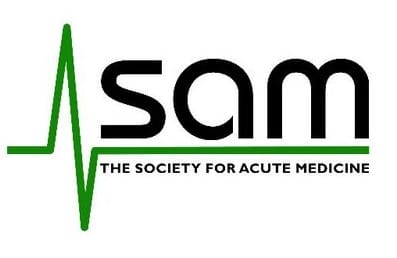View the Presentations from the conference here
Click on the links below to view the posters selected for display at SAMsterDAM2:
Audit and Quality Improvement Posters
AQI01: A quality improvement project to look at the use of clotting screens on patients admitted to AAU and a further cost-benefit analysis
AQI03: Age Adjusted D-dimer, Ready for Prime Time?
AQI04: Ambulatory Paracentesis – An audit and quality improvement project
AQI05: An evaluation of volume status assessment in acute kidney injury: A quality improvement project
AQI06: Delivering the fastest thrombolysis in acute ischaemic stroke in the UK: The quality improvement journey of a small rural district general hospital
AQI07: Did adding the EMR score to the Query PE proforma improve the management of patients with Pulmonary Embolism?
AQI08: Don’t just Datix®, try Greatix! Excellence Reporting on an AAU
AQI10: Enhancing the discharge process on the Clinical Decisions Unit
AQI11: Improving Fluid Management in AKI Patients: The ‘MAGNETIC’ Intervention
AQI12: Investigation of Acute Headaches on Ambulatory Emergency Care (AEC)
AQI13: Measuring ‘True Admission Avoidance’ in Ambulatory Care
AQI14: Patient Safety: Introduction of ward round safety checklist on AMU in Chester
AQI16: Reducing drug errors during medical admission
AQI17: Sprotte® the Difference
AQI19: The introduction of a dedicated discharge summary doctor improves patient flow during weekends at Bradford Royal Infirmary
Case Report Posters
CR02: A Case of Bilateral Adrenal Haemorrhage Post Total Knee Replacement with a Possible Link to Apixaban
CR04: Another case of hyperkalaemia?
CR05: Kikuchi’s disease in a returning traveller
CR06: Lactic Acidosis in Type-1 Diabetes Mellitus: What possibilities you consider?
CR07: More, Less or Both?
CR09: Scurvy, 250 years after Lind
CR12: What comes first? Heart or platelets….
Education Posters
E01: Acute medical emergencies: Our experiences of developing a teaching programme for medical students using simulated real-life scenarios
E02: Acute Medicine Finishing School
E05: Capabilities in Practice – A Novel Assessment Method for Postgraduate Physician Training
E06: Development of Simulation-based education for acute medical emergencies in Wales
E07: Education challenges on the AMU
E08: Is it time for a formal undergraduate Acute Medicine curriculum?
E09: Permanent skin pigmentation following extravasation of iron infusion
E10: Strong Transitions: The ultimate medical registrar preparation course
Research Posters
R01: A systematic review and meta-analysis on the effect of statins and antiplatelet drugs on D-dimer levels
R02: Arterial Blood Gas Analysis: As safe as we think? A multicentre retrospective cohort study
R03: CAM-ICU may not be the optimal screening tool for early delirium screening in older ED patients
R04: Comparing the predictive value of qSOFA score and SIRS criteria in COPD patients in the ED
R05: Comparison of the impact of AKI between common acute medical diagnoses
R07: Disease perception and clinical impressions of patients, nurses and physicians predict 30-day mortality and other adverse outcomes in older emergency patients
R09: Effect of appropriate empirical antibiotic therapy on mortality in patients with bloodstream infection is confounded in a general heterogeneous population
R10: Elderly patients visiting the ED in the Netherlands: A profile of patients’ and healthcare providers’ perspectives on preventability
R11: How do clinicians judge whether a patient is hypovolaemic and in need of intravenous fluid resuscitation: A qualitative study
R12: How does multiple myeloma present to acute services? Data from the TEAMM (Tackling Early Morbidity and Mortality in Myeloma) Trial
R13: Impact of Geographical Localization of Physicians to a Single Unit on Physician-Nurse Communication
R14: Long completion times in the ED: A root cause analysis
R15: POCUS in Recognising Papilloedema and Raised ICP on the Acute Medical Unit
R17: Prognostic value of quick-SOFA (qSOFA), Systemic Inflammatory Response Syndrome (SIRS) and clinical bedside judgement in the ED
R19: Repeated vital sign measurements in the ED predict patient deterioration within 72 hours: A prospective observational study
R21: Screening for vulnerability at the ED: Predictive value of frequently used screening instruments
R22: Screening instruments for identification of vulnerable older adults at the ED: A critical appraisal
R23: The influence of vasoactive medication on heart rate variability in patients presenting with sepsis at the ED
R25: Vital signs and impaired cognition in older ED patients: the APOP study
Service Organisation and Design Posters
SOD01: A morning cuddle – The impact of a morning AMU huddle
SOD02: A Novel Ambulatory CT Pathway for the AMU
SOD03: Adherence to Geriatric ED guidelines in routine care
SOD04: Annualisation of weekly working hours to implement Consultant delivered service during unsocial hours and Consultants Satisfaction
SOD06: Logistic Differences in EDs in The Netherlands
SOD07: Management of AF in Medical Ambulatory Care reduces hospital admissions and is cost effective
SOD09: Rota Change in Acute & General Internal Medicine: Improved Patient Care & Junior Doctor Training at the Front & Back Door- AMU Placement Blocks the Way Forward!
SOD10: Routine HIV testing in a West Midlands AMU
SOD11: takeAIM: A national campaign dedicated to addressing a recruitment shortfall in AIM to the NHS
SOD12: The Electronic Whiteboard in the Combined Assessment Unit Innovation in Flow, Governance and Process Efficiency
SOD15: Underutilisation of the ambulatory setting for investigation and management of suspected pulmonary embolism at a London teaching hospital
More posters will be added as we receive them
